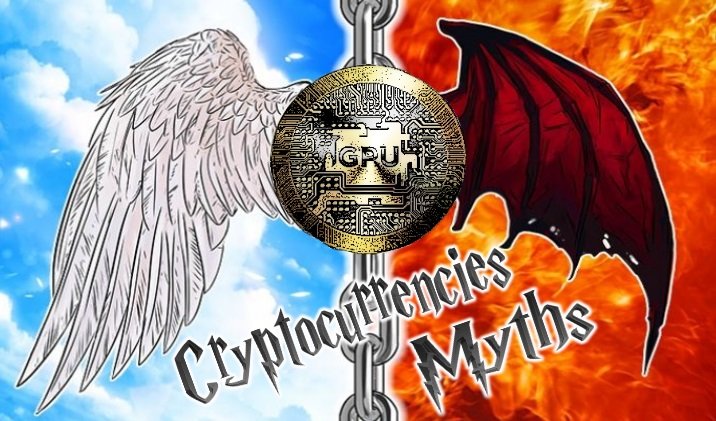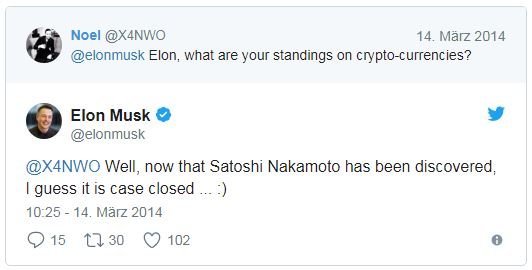
- The 10 Biggest Myths about Cryptocurrencies - Part 5!
- Did Elon Musk invent Bitcoin? A SpaceX Intern says yes!
- Bitcoin consumes more Power than 159 Countries - Really?
- Samsung and Seoul Government working on Blockchain Platform!
- Dnata successfully completes Blockchain Project!
- Philippines want to regulate Cryptocurrencies!
- Bitcoin Course Challenge Week 8!



In the series "The 10 Biggest Myths About Cryptocurrencies", I take a closer look at the top 10 claims about cryptocurrencies and their opportunities and risks. In doing so, I will daily explore a new myth and check it for accuracy.
Myth 5: The tax situation for cryptocurrencies is unclear
Anyone who chooses to invest in cryptocurrencies should first think about a few things to keep in mind. One of these things is the tax situation in which he goes through his investment. Otherwise, the inexperienced and uninformed investor can quickly move into the red zone of criminal liability without any or only insufficient taxation of any sales and profits - whether knowingly or unknowingly. And also when investing ultimately the old truism applies: Ignorance does not protect against punishment.
Thus, it is fundamentally discouraged to get involved in the business of cryptocurrencies without knowledge of the applicable taxation. It only becomes problematic if the tax situation around a certain investment case has not yet been clearly clarified. In this case, it sounds obvious to refrain from such an investment - so at least a common argument when it comes to the rejection of crypto investments for tax reasons.
In fact, at least for Bitcoin, there is a tax legislation that applies equally to cryptocurrencies whose operation is similar to that of Bitcoin. For example, there is a 2015 Court ruling by the European Court of Justice which ruled that Bitcoin's sales are covered by the foreign exchange tax exemption under EU law. This essentially means that cryptocurrencies are in most cases treated analogously to foreign currencies. For cryptocurrencies, which are not primarily intended as a means of payment, but have a certain function within an ecosystem, this principle does not apply, which is why the tax situation can not always be properly clarified.
In terms of income tax, cryptocurrencies are to be treated as intangible assets. Specifically, accurate ratings of each cryptocurrency depend on the function that it performs in a particular situation. Private sales transactions, so-called speculative transactions, occur when the cryptocurrency - for example, against the euro or the US dollar - is sold or when it is used as a means of payment. The acquisition date also plays a role: Cryptocurrencies, which have been held for a period of more than one year, are completely exempt from tax. In the case of a sale within the one-year holding period, there is also an exemption limit of € 600. The speculative period may be 10 years if the asset is a source of income, even if it only generates income in one calendar year. The trade of cryptocurrencies against other cryptocurrencies is expected to be taxed on profit.
The present myth can thus - at least as far as the Bitcoin is concerned - be invalidated. The tax situation of Bitcoin is largely clarified and differentiated for practically all circumstances. The situation of the other crypto currencies depends on function and application. If a cryptocurrency, like the Bitcoin, serves as an alternative payment method, then an application of the same right can be assumed. However, there is still a lot to do to understand the intricacies of crypto taxation - tax law is complicated and you should not take risks.
Disclaimer:
This article concerns more the tax situation in Europe.
I have given a little insight into the tax situation around Bitcoin and other cryptocurrencies. Neither do I claim to be complete - tax law is complex - nor does this article replace my own examination of the topic.
HERE you can read Part 1
HERE you can read Part 2
HERE you can read Part 3
HERE you can read Part 4


The blog entry of a former SpaceX intern has given new impetus to the search for the Bitcoin inventor, which has actually already ended. Now it should have been Elon Musk.
Bitcoin: Is Elon Musk behind it?
Around the inventor of the crypto-currency Bitcoin, which appeared under the pseudonym Satoshi Nakamoto, entwine for years speculation and conspiracy theories. One and a half years ago, Australian Craig Steven Wright had lied out as alleged Mr. Bitcoin - but this does not appear to be the end of the supposed revelations about the identity of the Bitcoin inventor. Now, a former SpaceX intern has brought Elon Musk into the picture.
Sahil Gupta, who claims to have completed an internship as a software developer at Musks SpaceX, explains in a media blog entry how he thinks it was his ex-boss. According to this, Musk has in-depth knowledge of economics and cryptography - like the man who wrote the paper on Bitcoin in 2008. In addition, Musk could program perfectly in C ++, the language in which Bitcoin was written.
Elon Musk is said to have invented Bitcoin - and this tweet is supposed to prove it
Of course that's not all, because this description fits a lot more people than just Elon Musk. Accordingly, Gupta refers to a Tweet Musk from 2014, which he regards as a kind of secret outing of the tech all-rounder as Mr. Bitcoin. Judge for yourself:
Unconvinced? For Gupta is further evidence that Elon Musk is behind the invention of Bitcoin, the choice of the pseudonym Satoshi Nakamoto. This is an anagram for "So a man took a shit" - and that's exactly Musk's style. Gupta does not even see two points as problematic, which would certainly convince many critics of the opposite: First, Elon Musk claims to not even own a Bitcoin. Moreover, it is unlikely that Musk would have kept the responsibility for such an invention secret for almost ten years.
Incidentally, the blog entry comes at a time when the Bitcoin price of close to $ 10,000 is about to hit a historic all time high. Is Elon Musk Mr. Bitcoin? Probably not, right?


A website estimates the power consumption of the Bitcoin network - and promptly says Bitcoin burns more power than 159 countries. For real?
The headline is of course a self-runner: Bitcoin "eats" more electricity than 159 countries. At almost 30 terawatts, the energy demand of the decentralized currency is about as high as that of Slovakia and only a bit lower than that of Denmark. This is of course not quite optimal and makes Bitcoin the climate killer number one among the payment systems.
What is really up to these messages? They refer to a "study" of the British power comparison portal Power Compare. However, this has taken only an estimate of the crypto news portal Digiconomist and illustrated by infographics. Digiconomist runs a Bitcoin Energy Consumption Index that reflects Bitcoin's hunger for electricity in a chart. Currently, the index is at around 30 terawatts, which is about as much as the state of Oman consumed and put Bitcoin in the power consumption ranking of the States to rank 65th
A critical look at the methodology of Digiconomist is unfortunately not found in any article. So how does the portal get this value?
"Although it's easy to calculate the absolute hash rate of the network, it's impossible to say what that means for energy use," says Digiconomist. The problem is that different mining machines have different levels of power consumption. In order to determine the total power consumption of Bitcoin, it has therefore been estimated in the past which machines are distributed in which ratio in the network. However, based on a report on the largest Bitcoin mine in the world, which was set up by Bitmain in Mongolia, Digiconomist concludes that such estimates neglect important factors, such as cooling, so the results so far were inaccurate.
"The Bitcoin Energy Consumption Index therefore proposes to turn the problem upside down and determine energy consumption from an economic perspective." Digiconomist assumes that there is a relationship between income and costs of miners. "Since electricity costs are a significant part of the miner's spending, it is logical that the absolute power consumption of the Bitcoin network is related to the revenues of the miners." So the index takes the miners' revenue at the current market price, estimates how much spend them on electricity (60 percent) and how much they pay for electricity (5 cents), and how much electricity Bitcoin should consume.
The bill goes something like this: You take the reward per block (12.5 Bitcoin + fees), multiply it times 144 (that's how many blocks are found around the day), and again with the current market price ($ 9,500). This is then extrapolated to one year to find out what the miners earn each year, takes 60 percent of what the annual electricity expenses can be, and charged with an electricity price of 5 cents per kilowatt hours.
The result is known: 30 terawatt hours a year, or as much as Oman or Slovakia. Roughly speaking, this value should not be implausible. But there are a few reasons to put it into perspective at least.
First, the baseline value seems to be too high. Digiconomist assumes electricity costs of 0.284 watts per Gigahash. The current Antminer, S9, however, requires just under a third, namely about 0.088 watts per Gigahash. Even the pre-predecessor, the S7, consumed less than 0.284 watts per gigahash. One can assume that the "additional energy costs" are set a little too high.
Second, a 60 percent value for electricity spending also seems a bit too high. Take a look at the Antminer S9, for example. It costs 1,415 dollars and consumes about 1.2 kilowatts. If, like Digiconomist, you start with an electricity price of 5 cents per kilowatt hour, the operation of the S9 costs 7 cents per hour or $ 613 per year. So the device has to run for more than 2 years so that the electricity costs are the targeted 60 percent of the total cost.
Third, Digiconomist assumes the current price, and assumes that it will be immediately implemented in Hashrate at the current state of the art. In fact, the retrofitting of miners in this wild year is almost always behind the rise in the price. And even if it comes after, the construction of the Hashrate is usually accompanied by a technical upgrade to more efficient miners. In other words, if miners have invested the network's current revenues in hardware, the rate of gigahash per watt will have continued to improve.
An interesting case study is the Bitmain Mine in Mongolia, described by Digiconomist himself. It consists of 21,000 miners, which are housed in eight buildings. In early August, when the mine was visited by several media outlets, it allegedly generated nearly 4 percent of the total bitcoin hashrates and consumed 40 megawatts per hour. If you extrapolate that, the network at that time had a total consumption of 1,000 megawatts per hour, resulting in an annual consumption of about 8.7 terawatts. According to the index, electricity consumption has more than tripled since the beginning of August (while the rate of hashrates itself has not even doubled).
The Bitcoin Energy Consumption Index is unable to maintain consistency with its own case study. This shows that one must enjoy the results with caution. As good as 30 terahash, the network could have a consumption of 10 terahash - as well as 40 terahash. One thing is clear - we have an order of magnitude. At best Bitcoin consumes "only" as much energy as a country like Uruguay (rank 90), in the worst comes the cryptocurrency on electricity costs of the format of a state like New Zealand (rank 55).
That sounds dramatic, and it does, to a degree. However, this is put into perspective when you realize that it's more likely to be the big industrialized nations investing excess energy in mining. You could say, for example, that China needs to put in just 0.5 percent of its annual electricity bill to power its entire Bitcoin network, or 0.7 percent of US consumption.
In addition, Digiconomist's statistics suggest a much more interesting line of thought than sheer outrage: if the average Bitcoin mining power cost is about 5 cents, and miners burn 30 terawatts a year, then that means it's in the world 30 terawatts of excess electricity that can not manage to generate more than 5 cents per kilowatt-hour. The Bitcoin hashrate, in this sense, becomes an indicator of how lucrative power is otherwise used.


The South Korean electronics manufacturer Samsung has announced plans to work with the regional government of the capital Seoul in the future. The aim of the cooperation is the development of a blockchain platform that is to be used by the public administration of the metropolitan region.
According to South Korean media, Samsung SDS, an IT division of the international giant Samsung, has signed an agreement with the regional government of the Seoul metropolitan area. In it, the expansion of Samsung's business from the private sector to the public sector was initiated. In the future, Samsung wants to work on the government's project of integrating blockchain technology more closely in the administration.
The fields in which the capital's government wants to capitalize on the blockchain range from organizing the city's welfare state, to public security, to infrastructure and transportation. The implementation of a blockchain solution in the administration of the city should bring tangible changes as early as 2022, in order to make the entire processes in the public sector more transparent and to build trust in the population.
Samsung SDS introduced its blockchain platform Nexledger at the beginning of the year and configured it with the Samsung Card. Last month, the application of the platform was tested for logistics for the first time, using it in shipping companies.
CEO of Samsung SDS, Hong Win-Pyo says:
The blockchain excitement in South Korea comes at a time when especially the crypto trade on the peninsula is under strict observation. So it was after the China South Korea, which pronounced a ban on ICOs.


Dnata, a Middle Eastern travel and air services provider, announced that it has successfully completed a pilot project for the use of the blockchain for air freight services in Dubai.
Among others, companies such as IBM, the Emirates Innovation Lab and Flydubai Cargo were involved in the pilot project. The investigation addressed several possible uses of the blockchain, security issues and legal issues.
The investigation was "successful" and was carried out using a new logistics platform developed by the participants of the project. Blockchain was responsible for tracking transactions throughout the supply chain.
Neetan Chopra, Emirate Group's senior vice president of IT services, initially stated that blockchain technology and its potential are neither easy to understand nor easy to value.
He also said:
Currently, the aviation industry is exploring different uses of the new technology. For example, service provider SITA had published a white paper stating that smart contracts could be used for the aviation industry. Air France is also currently investigating the blockchain as a way to record the whereabouts of goods.


The Philippines Securities and Exchange Commission (SEC) has announced that they are considering legalizing the use of cryptocurrencies in the country. To make this possible, it is necessary to classify them as securities from now on. The move follows the call of financial regulators for a single regime for digital currencies.
As the Manila Times reports, the Securities and Exchange Commission of the fifth largest island nation in the world announced in a news conference in late November that the agency is adjusting cryptocurrencies to the legal system.
SEC member Emilio Aquino explains:
According to Aquino, the SEC will also discuss the recognition and licensing of cryptocurrencies in the country, which will then be controlled by the central bank, Bangko Sentral. He also added that the central bank has already registered and endorsed five companies as file-sharing exchanges. However, the legal classification and the powers of the exchange stock exchanges are not yet completely clarified.
Bank Manager expresses himself positively
The head of central bank Melchor Plabasan has also recognized that cryptocurrencies are very valuable instruments for investments. The risks are in his opinion to get a grip.
The state in the Pacific Ocean is thus oriented to regulations of New Zealand, Singapore and the USA. As I reported for example, the SAFT project seeks to circumvent the classification of cryptocurrencies as securities.
Like many other companies and states, the Philippines is thus busy with the regulation of Bitcoin & Co. Already last year in June in the Philippines, a regulation of cryptocurrencies after an attack on the SWIFT system was considered. In addition, the Philippine Central Bank has issued a statement earlier this year, after the leadership of crypto exchanges should be simplified.


Don't miss your CHANCE to Win 💰 20 Whaleshares + 40 Hairshares💰 in the 🏆BITCOIN COURSE CHALLENGE Week 8🏆
How and where to participate? Just click HERE!


I wish you all a lovely Tuesday!!!
ⓁⓄⓥⒺ & ⓁⒾⒼⒽⓉ
Best regards
@danyelk
.gif)







Very good
Thanks :)
Yes you are welcome.
you are a great person
I will always follow you every day
Thank you for your kind words and follow :)
Yes, you are welcome.
success is always my friend
i just upvote you & you back upvote my post ....please
Thank you for the upvote and I will check out your blog and if I like your content you get an upvote ;)
Hello ! I just read your content, I love it. Follow me @osmanie and I follow you too!
its not really a 2 min read... So kindly fuck off:)
I could not have said it better bro ;)
haha you know how we roll :) I am still reading and its almost 10 min... It is true I read slowly as a kid should:P
And what we roll lolz ;)
I am glad your reading my post bro take your time better to read slow but understand all then fast and understand just half of it :)